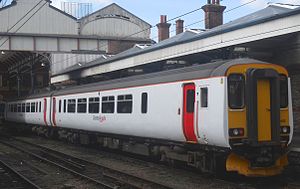British Rail Class 156
| British Rail Class 156 Super Sprinter | |
|---|---|

Abellio Greater Anglia Class 156 No. 156402 at Norwich
|
|

The interior of Abellio Greater Anglia refurbished Class 156
|
|
| In service | 1987 - Current |
| Manufacturer | Metro-Cammell |
| Order no. |
|
| Built at | Washwood Heath works |
| Family name | Sprinter |
| Replaced | First generation DMUs |
| Constructed | 1987 – 1989 |
| Entered service | 1988 |
| Number built | 114 trainsets |
| Formation |
|
| Diagram |
|
| Fleet numbers |
|
| Capacity |
|
| Operator(s) |
|
| Depot(s) | |
| Specifications | |
| Car body construction | Steel |
| Car length | 23.025 m (75 ft 6.5 in) |
| Width | 2.730 m (8 ft 11.5 in) |
| Height | 3.805 m (12 ft 5.8 in) |
| Floor height | 1.135 m (3 ft 8.7 in) |
| Doors | Single leaf sliding |
| Articulated sections | 2 |
| Wheelbase | 16.000 m (52 ft 5.9 in) (bogie centres) |
| Maximum speed | 75 mph (121 km/h) |
| Weight |
|
| Prime mover(s) | 1 × Cummins NT855-R5Diesel (per car) |
| Power output | 570 hp (430 kW) |
| Transmission | |
| Train heating | Hot air from single heat exchanger |
| Bogies |
|
| Braking system(s) | Air/EP |
| Safety system(s) | |
| Coupling system | BSI |
| Multiple working | Classes 14x, 15x, 17x |
| Track gauge | 1,435 mm (4 ft 8 1⁄2 in) Standard gauge |
The British Rail Class 156 Super Sprinter is a diesel multiple-unit train (DMU). 114 of these units were built from 1987 to 1989 by Metro-Cammell (now owned by Alstom) at its Washwood Heath works in Birmingham. They were built to replace elderly first-generation "Heritage" DMUs and locomotive-hauled passenger trains.
The design of the Class 156 was more conservative than Metro Cammell's earlier Class 151 design. The bodyshell was made of steel instead of aluminium, and the cab design was deliberately similar to the BREL Class 150 to ease union acceptance.
The units were all built as two-car sets, numbered 156401-514. Each unit was formed of two driving motors, one of which contained a toilet. Individual carriages numbered as follows:
The vehicles are powered by 6-cylinder Cummins NT855-R5 diesel engines through Voith T211r hydraulic automatic transmissions and Gmeinder final drive units. They have a top speed of 75 mph (121 km/h).
Unlike the Class 150 units, the 156s have a single-leaf sliding door at either end of each coach. This reflected the expected longer journeys with fewer stops that the Class 156 was supposed to operate. As with the Class 150, all the doors are operable by passengers when released by the guard using one of two passenger door control panels; they are energised using a carriage key to turn a rotary switch situated on the cab bulkhead. Units operated by Abellio ScotRail have additionally been fitted with door-control panels near the centre sets of doors for the convenience of the guard.
The first 100 units were all ordered by the Provincial Sector of British Rail, and carried the sector's livery of blue and beige with light blue stripe. Twenty units, numbers 156401-419/422 based at Tyseley depot, were later repainted into Regional Railways Express livery after the rebranding of Provincial.
...
Wikipedia
